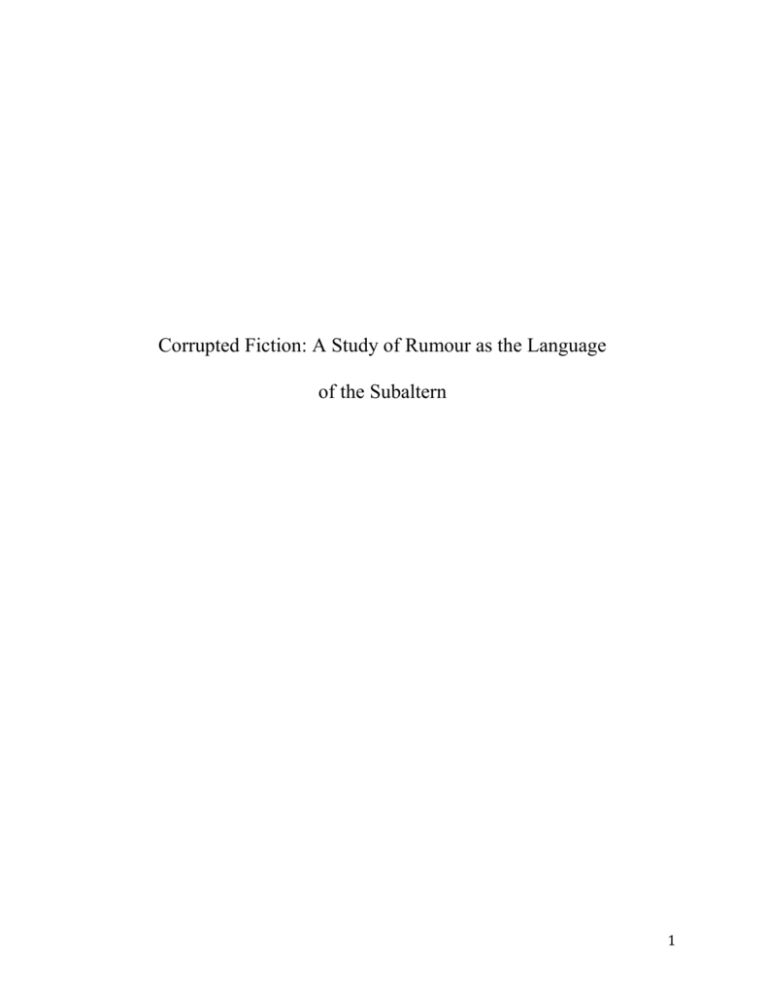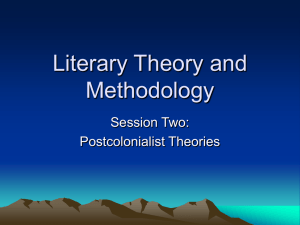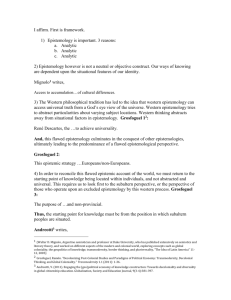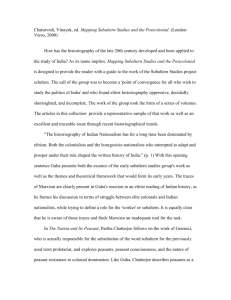Corrupted Fiction: A Study of Rumour as the Language of the
advertisement

Corrupted Fiction: A Study of Rumour as the Language of the Subaltern 1 Abstract Subaltern communities are the most difficult groups to historically study because they leave behind very few written sources. Communication within subaltern society is primarily oral. The information that circulates is usually based on rumours whose narratives change rapidly over time and distance. Thus, historians often disregard rumour as the process by which truth becomes corrupted. Although historians frequently study rumour as a tool that incites popular reaction, they rarely observe it as a language that reflects subaltern perspectives. Thus, this paper provides a methodology by which historians can study rumours as a language within subaltern communities. Through compiling a historiographical study of rumours in different subaltern societies, this paper outlines how historians can use rumours to determine the psychology of subaltern communities, the parameters of those communities, and the ways in which those communities interacted with the state. Moreover, this paper also invents a vocabulary to discuss the specific ways in which rumours affect their audience. Rumours are an extremely valuable source of historical information because they are one of the only forms of communication that the subaltern can access. Much can be inferred about the characteristics of subaltern communities from the ways in which they narrate rumours. Five Key Words: Rumour, Subaltern, Language, Historiography, Fiction 2 Introduction The Malay word for rumour is khabar angin, which means “news on the wind.” Lacking a known author or origin, rumours are both rousing and unverifiable. Rumours spread quickly and change constantly. It is precisely the elasticity of rumours that complicates their study for historians. If rumours constantly evolve, how can they be used to investigate that which actually occurred? Is their metamorphosis random, or is it partly determined by societal conditions? There is surprisingly little historical analysis that answers these questions. Most historians regard rumour as a process by which truth is corrupted; rumours are the fictional content of speech rather than a way of transmitting information. However, this paper will analyze rumours as a language of the subaltern. Specifically, this paper will identify the particular attributes of rumours that make it a form of speech. By examining rumour as a language, historians can access unique information about the psychology of subaltern actors. For illiterate populations who have no access to the state’s authoritative knowledge, rumours are the way in which the subaltern informs each other of extra-local change, making communication beyond the village possible. Moreover, rumour narratives change according to the psychological conditions of society. Rumours act as a repository for the subaltern’s anxieties, aspirations and fears. They also form a basis for subaltern communities, uniting the subaltern around collective concerns. In these ways, rumours exist as a language that shapes both individual and communal identities. This paper will provide a framework through which historians can analyze rumours as representing different qualities of subaltern lives. 3 I. Rumours Have Authority in the Subaltern Although rumours are often considered a trivial form of discourse, they have authority in subaltern societies. Colonized communities, oppressed groups and illiterate persons rely upon rumours to explain their surroundings. As Georges Lefebvre wrote of 1789 rural France, “The vast majority of the French people depended entirely on oral tradition for the dissemination of news … In the empty silence of the provinces, every word had the most extraordinary resonance and was taken as gospel.”1 Subaltern communities are structured around the oral transmission of information. In part, the authority of oral speech derives from a lack of alternative sources. However, the subaltern also considers rumours authoritative because they are created and transmitted by the subaltern. For example, African-American slaves formed dense kinship networks in which rumours of cruel masters and escaped slaves circulated.2 These rumours were trusted because they were spread by the slaves themselves as opposed to their masters. As Gayatri Spivak notes, “It is more appropriate to think of the power of rumour in the subaltern context as deriving from its participation in the structure of illegitimate writing than the authoritative writing of the law – it is itself sanctioned by the phonocentric model of the spirit of the law.”3 The subaltern use rumours to circulate information in a sphere that is separate from, and often in opposition to, their rulers. Thus, rumours become authoritative because they are a discourse controlled by the subaltern. Georges Lefebvre, The Great Fear of 1789; Rural Panic in Revolutionary France. (New York: Pantheon, 1973), 73-74. 2 Steven Hahn, "Could Slaves Enfranchise Themselves? Rumour, Narratives, and Arenas of Politics in the American South," in Subaltern Citizens and Their Histories: Investigations from India and the USA, ed. Gyanendra Pandey. (London: Routledge, 2010), 183. 3 Gayatri Spivak, "Subaltern Studies: Deconstructing Historiography," in Selected Subaltern Studies, ed. Ranajit Guha and Gayatri Chakravorty. Spivak. (New York: Oxford University Press, 1988), 23. 1 4 The dearth of formal information channels is partly responsible for the subaltern’s act of generating rumours. Rumours become an authoritative voice when there is a palpable desire to access unavailable information. In Allport and Postman’s seminal text The Psychology of Rumor, they posit that during World War II “the almost total absence of fear-inspired rumors in Britain … was due to the people’s conviction that the government was giving full and accurate news of the destruction and that they, therefore, knew the worst.”4 In contrast, the American government did not release details of the losses at Pearl Harbor. Consequently, “the public had no secure standard of evidence by which to check and control its frightened imagination. So widespread and upsetting were the tales that President Roosevelt … [devoted] part of his fireside chat … to a repudiation of these bogy rumors.”5 Rumours develop when the desire for knowledge is met with an absence of credible information. Historians can identify time periods of widespread apprehension by the quantity of rumours generated thereafter. For example, Ranajit Guha describes this anxiety as an “inflammable haziness.”6 J. Kaye also contends that preceding rumours of mutiny in India’s Sepoy War was “an uneasy feeling – an impression that something had happened, though they could not discern the shape thereof – [that] persuaded men’s minds.”7 Subaltern societies generate rumours to answer the questions that they feel need to be answered. Thus, historians can use rumours as evidence of a subaltern community’s concerns, queries, or conceptions of abnormal behaviour. Gordon Allport and Leo Postman, The Psychology of Rumor (New York: Russell & Russell, 1965), 1. Allport and Postman, 3. 6 Ranajit Guha, Elementary Aspects of Peasant Insurgency in Colonial India (Delhi: Oxford University Press, 1998), 260. 7 John Kaye and G.B. Malleson, History of the Indian Mutiny (London: Longmans Green, 1898), 355. 4 5 5 II. All Rumours Have an Inciting Element Rumours evoke an emotional response in the listener that compels them to repeat the rumour. I have called this response the rumour’s “inciting element.” For a rumour to be considered worth repeating, it must have an inciting element that is powerful enough to compel an individual to become the rumour’s transmitter. Although no historian has specifically labeled this element, almost all those who have analyzed rumours recognize its existence. James Scott claims that “life-threatening events such as war, epidemic, famine and riot are … among the most fertile social sites for the generation of rumors.”8 Certainly, impending fatality is the most inciting of all inciting elements. J. Prasad in his study of Bihar earthquake rumours claims that anyone who came in contact with a rumour had “an almost uncontrollable impulse to pass it on to another person.”9 In December 1998, one widespread rumour in Lima’s impoverished neighbourhoods was that “gringo doctors … were entering the shantytowns, kidnapping children, and extracting their eyes in order to sell them abroad.”10 Although this rumour seems too fantastic to be believable, the rumour was ignited following an influx of white doctors to Peru’s spiritual urban areas. Fear of foreigners is a powerful inciting element, largely because the subaltern has no standard of behavior of which to expect. This rumour was so widely believed that on 9 December 1998 three French tourists were almost lynched for allegedly kidnapping twenty children.11 Similarly, the spread of gossip, which is just one kind of rumour, is almost entirely driven by the intrigue of illicit behaviour. For a rumour to spread, it must evoke an emotion that compels people to repeat the narrative. 8 James Scott, Domination and the Arts of Resistance: Hidden Transcripts (New Haven: Yale UP, 1990), 144. J. Prasad, The Psychology of Rumour: A Study Relation to the Great Indian Earthquake of 1934 (Emitsburg, MD: National Emergency Training Center, 1935), 11. 10 Gareth Williams, “Death in the Andes: Ungovernability and the Birth of Tragedy in Peru,” The Latin American Subaltern Studies Reader, ed. Ileana Rodriguez (Durham: Duke University Press, 2001), 273. 11 Williams, 274. 9 6 The inciting element is a useful window into the mentality of the subaltern. A rumour is spread because its audience finds the inciting element compelling, indicating to historians the types of concerns relevant to certain subaltern communities. For example, in Speaking with Vampires, Luise White traces the evolution of vampire rumours in East Africa to the fear of invading white settlers. Additionally, perhaps the most shocking rumour in American history is that of witchcraft in late 17th century Massachusetts. It is impossible to tell if the Salem Witch Trials would have occurred had Cotton Mather not stood upon a pulpit before the insular village and swore that “stupendous witchcraft” had poisoned John Goodwin’s children.12 Yet, presuming that witchcraft did not in fact spread through Salem Village in 1692 (and there is compelling reason to believe that it did not), Mather’s declaration likely corresponded with the deep spiritual anxiety that plagued many Puritan communities in the late 17th century.13 Similarly, Guha argues that “rumour proved to be a powerful vehicle of the hopes and fears, of visions of doomsdays and golden ages, of secular objectives and religious longings, all of which made up the stuff that fired the minds of men.”14 The inciting element provides the historian valuable insight into the subaltern’s psychology because it illuminates the types of concerns and conflicts that occupied their minds. III. The Speed and Span of a Rumour’s Transmission is Determined by the Magnitude of the Inciting Element Rumours are said to spred quickly. They travel even more rapidly when their message is considered urgent. Historians can evaluate how deeply a rumour’s inciting element resonates Cotton Mather, Memorable Providences Relating to Witchcrafts and Possessions (Boston: Printed by R.P., 1689), 12 13 Hannah Heaton and Barbara E. Lacey. The World of Hannah Heaton: The Diary of an Eighteenthcentury New England Farm Woman (DeKalb: Northern Illinois University Press, 2003). 14 Guha, 256 12 7 with its audience by the speed at which the rumour travels. The inciting element provokes a primal emotional response in the audience that induces them to spread the rumour. Fear requires placation, and shock spurs explanation. It is not surprising that James Scott commented that the fastest-moving rumours are those concerning “life-threatening events such as war, epidemic, famine and riot.”15 Indeed, Prassad attributes “a part of the explanation of the rapid transmission of the stories and prophecies of disaster” to the “uncontrollable” fear that the rumours spurred.16 Rumours about man-made cataclysms apparently travelled equally fast.17 J. Kaye, a historian of the Sepoy War, commented that “a certain description of news, which travels in India, from one station to another, with a rapidity almost electric … had travelled another hundred miles whilst the white gentlemen, with bland skepticism, were shaking their heads over the lies of the Bazaar.”18 This example is particularly illustrative of the difference between the spread of rumours in the subaltern and the state. The subaltern has little access to the authoritative knowledge required to either verify or disprove a rumour; they do not have the privilege of dismissing rumours. Thus the speed at which a rumour spreads in the subaltern is determined by the degree to which its inciting element is found compelling. Similarly, a rumour is transmitted across populations only insofar as the audience finds the inciting element of the rumour relevant. An individual who does not care about a rumour is unlikely to repeat it. Thus, historians can use the spread of rumours to trace the scope of subaltern societies. In this regard, there are a variety of interesting studies that have tracked the movement of rumours. In 1893, a rumour moved across Bihar and neighbouring Indian provinces which prompted local populations to mark their trees – a practice known as “tree 15 Scott, 144. Prassad ,11. 17 John Kaye, A History of the Sepoy War in India, 1857-1858, (London: W.H. Allen, 1880), 491. 18 Guha, 258. 16 8 daubing.”19 First noticed by the Sitamarhi Subdivisional Officer in January 1894, the practice of tree marking “extended across … an area of over 23,000 square miles, and also moved to points several hundred miles of the east and west of the epicenter of the outbreak” within the short time span of four months.20 The official records of this tree-daubing “panic” suggest that the rumour spread by word of mouth along the area’s main roads.21 It is now suggested that sadhus, Hindu nomadic monks, were likely the transmitters of the rumour. Yet, as Anand Yang contends, “[the sadhus’] message could never have gained the measure of dissemination it did without the help of a receptive audience who, in turn, became rumormongers themselves.”22 Similarly, Luise White, in her analysis of vampire rumours in East Africa, uses language to trace the spread of the rumour.23 The Swahili term banyama, which was originally used to describe game rangers in Northern Rhodesia, was translated to mean “vampire” as early as 1931. Within ten years, the word banyama spread throughout Bemba and Nyanja speaking areas, and it came to represent white doctors that were rumoured to forcibly extract the blood of Africans for medical purposes. White suggests that although the rumours of the banyama differ across pockets of East Africa, the consistent language proves the rumours to be essentially the same. Tracing the spread of the banyama rumour is akin to tracing African anxiety of white settlers. Thus, historians can study the movement of rumours to determine the parameters of subaltern communities. 19 Anand Yang, “A Conversation of Rumors: The Language of Popular Mentalités in Late NineteenthCentury Colonial India,” Journal of Social History 20.3 (1987), 487 20 Egerton, “Notes on Tree Marking,” Facts From Bihar, 279-280. Reprinted in Yang, “A Conversation of Rumors,” 500. 21 Yang, 500 22 Ibid 23 White, 50-60 9 IV. A Rumour’s Narrative May Change But the Inciting Element Does Not If rumours are known for one quality, it is that their narratives constantly change. As a rumour travels between its transmitters, the narrative’s events and actors are usually drastically altered. These changes are not random. Rather, a rumour develops according to the subaltern’s interpretation of the inciting element. The subaltern changes the rumour’s narrative to make the inciting element make sense. For example, in a study cited by Allport and Postman, American sociologists showed an audience a picture of a white man threatening an unarmed black man with a razor. When the audience was asked to recount this narrative, more than half of the white audience members claimed that the black man had held the razor against the unarmed white man.24 While the inciting element of the rumour was the same, the actors had been altered according to the fears of the audience. As Scott claims, when “a rumor travels it is altered in a fashion that brings it more closely into line with the hopes, fears and worldview of those who hear it and retell it … On this basis one must expect rumors to take quite divergent forms depending on what class, strata, region, or occupation they are circulating in.”25 Indeed, history is littered with examples of rumours whose plot or actors change in their retelling.26 Communities reinterpret the rumour within their specific societal context, changing its narrative in order to make the inciting element feel compelling. Thus, the same rumour might travel great distances, but always concern ‘the village next door.’27 Changes to a rumour’s narrative indicate different interpretations that subaltern populations cast upon the same inciting element. 24 Allport and Postman, 75. Scott, 145. 26 For a truly excellent index of rumours whose narratives have changed over time, observe Shahid Amin, “Gandhi as Mahatma,” Selected Subaltern Studies, 314-331. 27 See the example of the alleged pollution of the Mishrain’s household in both Gorakhpur and Deoria in Shahid Amin, “Gandhi as Mahatma,” Selected Subaltern Studies, 320-321. 25 10 V. Rumour is a Discourse of Power Fabricating a narrative to induce specific human behaviour is manipulation. Thus far, this paper has analyzed the transmission of rumours with a ‘natural origin.’ By ‘natural origin,’ I mean that the rumour’s initial claim was not made with the intention of creating a rumour. Instead, the claim was molded into rumour through its perpetual retelling. However, some rumours are created intentionally. Sometimes an instigator crafts a rumour to incite a specific popular reaction. For example, contemporary historians largely agree that the Nazis blamed the 1933 Reichstag fire on the Communist Party so that they could consolidate their political support. Similarly, to stop bandits from rampantly looting the under-policed areas of Buenos Aires, it is now thought that the Argentinean police force crafted the widespread rumour that a massive looting attack would occur in December 2001.28 The rumour had “a demobilizing effect, keeping people at home, defending their barrios, thus preventing further looting.”29 Historians must attempt to investigate the origin of specific rumours so as to contextualize it within the mentality of the subaltern. If the subaltern neither created nor shaped the rumour’s narrative, it would be incorrect to assume that the narrative represented the subaltern social consciousness. Of course, the ways in which state authorities choose to craft rumours to manipulate the subaltern is also worth analyzing. Such studies require historians to carefully trace the origins of rumours in order to interpret its meaning for the subaltern. The circulation of rumours within society is a discourse of power between the subaltern and the state. Given the tremendous influence that rumours wield over subaltern populations, both the state and subaltern actors have strong incentives to control the spread of rumours. Slave 28 Lindsay DuBois, “The Looters are Coming! The Looters are Coming!: Moral Panic and the Argentina Crisis.” Paper presented as part of American Anthropological Association Annual Meeting (New Orleans, November 20, 2002). 29 Javier Auyero, Routine Politics and Violence in Argentina: The Gray Zone of State Power (Cambridge: Cambridge UP, 2007), 129. 11 masters wanted to quash all rumours of slave escapes while slaves had every ambition to spread this information. Thus, the language of rumours within the subaltern is tailored to the challenges that those rumours face. The Raj, among other colonial administrations, planted spies within the bazaars in order to intercept rumours.30 Accordingly, Indian citizens who were aware of the domestic espionage transmitted their rumours in private or in code. On a local level, the Raj tailored its form of governance according to local levels of disaffection.31 Thus, subaltern rumours were a legitimate tool of power because their content could dictate colonial policy. The transmission of subaltern rumours in colonial India walked a fine artistic line; they had to deceive potentially eavesdropping colonial administrators while simultaneously conveying the essence of their message to fellow subaltern actors. Historians should observe the sites of rumour proliferation, like the markets or the bazaars, as theatres of performance. Rumours were performed so that the authorities or the subaltern could gain power over the other. Sometimes the subaltern overtly uses rumours to manipulate the behaviour of the authorities. In his analysis on social aggression in Andalusian villages, David Gilmore contends that the landless poor used rumours to coerce rich landowners into treating them better.32 Similarly, Scott describes that “one might give people hard looks or perhaps cup one’s hand to a friend’s ear as the victim passes on the street. The purpose is to punish, chastise, or perhaps even drive out the offender.”33 The subaltern can use rumours to shame the authority into submission. However, this form of coercion is only possible when the power imbalance between the authority and the subaltern is slight. If one actor has the ability to completely annihilate the other and suffer no social or legal recourse, then such public displays of rumour mongering merely 30 Guha, 258. Kaye, 361. 32 David Gilmore, Aggression and Community: Paradoxes of Andalusion Culture (New Haven: Yale University Press, 1987), 13. 33 Scott, 143 31 12 jeopardize the subaltern’s security. Rumours provide the subaltern a language through which they can increase their power, either by communicating indirectly with the authorities or by making the subaltern community holistically more informed. Ultimately, rumours represent the subaltern’s interpretations of the state’s behavior. Given that the subaltern is generally prohibited from verbally engaging with administrators on an individual level, rumours of the state’s behavior are spread from a purely observational standpoint. As Luise White notes, “rumor may simply be poised between an explanation and an assertion: it is not events misinterpreted and deformed, but rather events analyzed and commented upon.”34 Indeed, historians should observe the spread of rumours as a discourse of interpretation. This interpretation is critical to the role of rumour as a power dialogue. Returning once more to the example of looting in 2001 Argentina, rumours comprised a complex informational network between policemen, looters and property owners.35 Rumours of police behavior were relayed to the looters, and rumours on looters’ behavior were transmitted to the police and property owners. The rumours themselves were guesswork – snippets of conversation and stolen images. Sometimes the rumours were deliberately deceitful. Part of the historical study of rumours entails identifying the rumour’s intended audience, which may very well be comprised of multiple groups. Rumours comprise a large network of information sharing that is structured around the discourse of power between the subaltern and the authorities. 34 35 White, 58. Auyero, 130. 13 Conclusion Rumour is an important form of speech to study because it is the language of the subaltern. It forms the narrative of a story and the language deployed. It also constitutes the many ways in which the narrative is altered upon repetition, and the reaction that it evokes within its audience. Rumour is the vehicle by which the subaltern transmits information to each other, and the method way by which the subaltern negotiates power within the state. Historians have often discounted rumour as the process by which truth becomes distorted. Certainly, rumour does morph the initial claim into seemingly unrecognizable forms. Yet, the very ways in which a story is distorted is indicative of society’s psychological conditions. Narratives change to align with a population’s values. The subaltern makes rumours make sense within their social context. The element of the rumour that never changes is the inciting element. The essence of the rumour – the emotion that it triggers – remains consistent in the rumour’s retelling. By tracing the movement of these qualitatively different but essentially identical stories, historians can locate subaltern communities. They can draw the parameters of like-feeling people; the spread of rumours identifies the groups of people whom share the same anxieties, fears and hopes that the narrative evokes within its audience. Rumour is not a distorted story, but a language that informs the historian of the subaltern’s thoughts. 14 Works Cited Allport, Gordon W., and Leo Joseph Postman. The Psychology of Rumor. New York: Russell & Russell, 1965. Print. Amin, Shahid. "Gandhi as Mahatma." Selected Subaltern Studies. Ed. Ranajit Guha and Gayatri Chakravorty. Spivak. New York: Oxford UP, 1988. N. pag. Print. Auyero, Javier. Routine Politics and Violence in Argentina: The Gray Zone of State Power. Cambridge: Cambridge UP, 2007. Print. DuBois, Lindsay. "The Looters Are Coming! The Looters Are Coming!: Moral Panic and the Argentina Crisis." American Anthropological Association Annual Meeting. New Orleans. 20 Nov. 2002. Lecture. Gilmore, David D. Aggression and Community: Paradoxes of Andalusian Culture. New Haven: Yale UP, 1987. Print. Guha, Ranajit. Elementary Aspects of Peasant Insurgency in Colonial India. Delhi [u.a.: Oxford Univ., 1998. Print. Guha, Ranajit. "The Prose of Counter-Insurgency." Selected Subaltern Studies. Ed. Ranajit Guha and Gayatri Chakravorty. Spivak. New York: Oxford UP, 1988. N. pag. Print. Hahn, Steven. "Could Slaves Enfranchise Themselves? Rumour, Narratives, and Arenas of Politics in the American South." Subaltern Citizens and Their Histories: Investigations from India and the USA. Ed. Gyanendra Pandey. London: Routledge, 2010. N. pag. Print. 15 Heaton, Hannah, and Barbara E. Lacey. The World of Hannah Heaton: The Diary of an Eighteenth-century New England Farm Woman. DeKalb, IL: Northern Illinois UP, 2003. Print. Kaye, John W. A History of the Sepoy War in India, 1857-1858. London: W.H. Allen, 1880. Print. Kaye, John William, and G. B. Malleson. History of the Indian Mutiny. London: Longmans, Green, 1898. Print. Lefebvre, Georges. The Great Fear of 1789; Rural Panic in Revolutionary France. New York: Pantheon, 1973. Print. Mather, Cotton. Memorable Providences Relating to Witchcrafts and Possessions a Faithful Account of Many Wonderful and Surprising Things That Have Befallen Several Bewitched and Possesed Person in New-England, Particularly a Narrative of the Marvellous Trouble and Releef Experienced by a Pious Family in Boston, Very Lately and Sadly Molested with Evil Spirits : Whereunto Is Added a Discourse Delivered Unto a Congregation in Boston on the Occasion of That Illustrious Providence : As Also a Discourse Delivered Unto the Same Congregation on the Occasion of an Horrible Selfmurder Committed in the Town : With an Appendix in Vindication of a Chapter in a Late Book of Remarkable Providences from the Calumnies of a Quaker at Pen-silvania. Printed at Boston in N. England: By R.P., 1689. Print. Prasad, J. The Psychology of Rumour: A Study Relating to the Great Indian Earthquake of 1934. Emmitsburg, MD: National Emergency Training Center, 1935. Print. 16 Scott, James C. Domination and the Arts of Resistance: Hidden Transcripts. New Haven: Yale UP, 1990. Print. Spivak, Gayatri. "Subaltern Studies: Deconstructing Historiography." Introduction. Selected Subaltern Studies. Ed. Ranajit Guha and Gayatri Chakravorty. Spivak. New York: Oxford UP, 1988. N. pag. Print. White, Luise. Speaking with Vampires: Rumor and History in Colonial Africa. Berkeley, CA: University of California, 2000. Print. Yang, Anand A. "A Conversation of Rumors: The Language of Popular "Mentalites" in Late Nineteenth-Century Colonial India." Journal of Social History 20.3 (1987): 485-505. Print. 17






